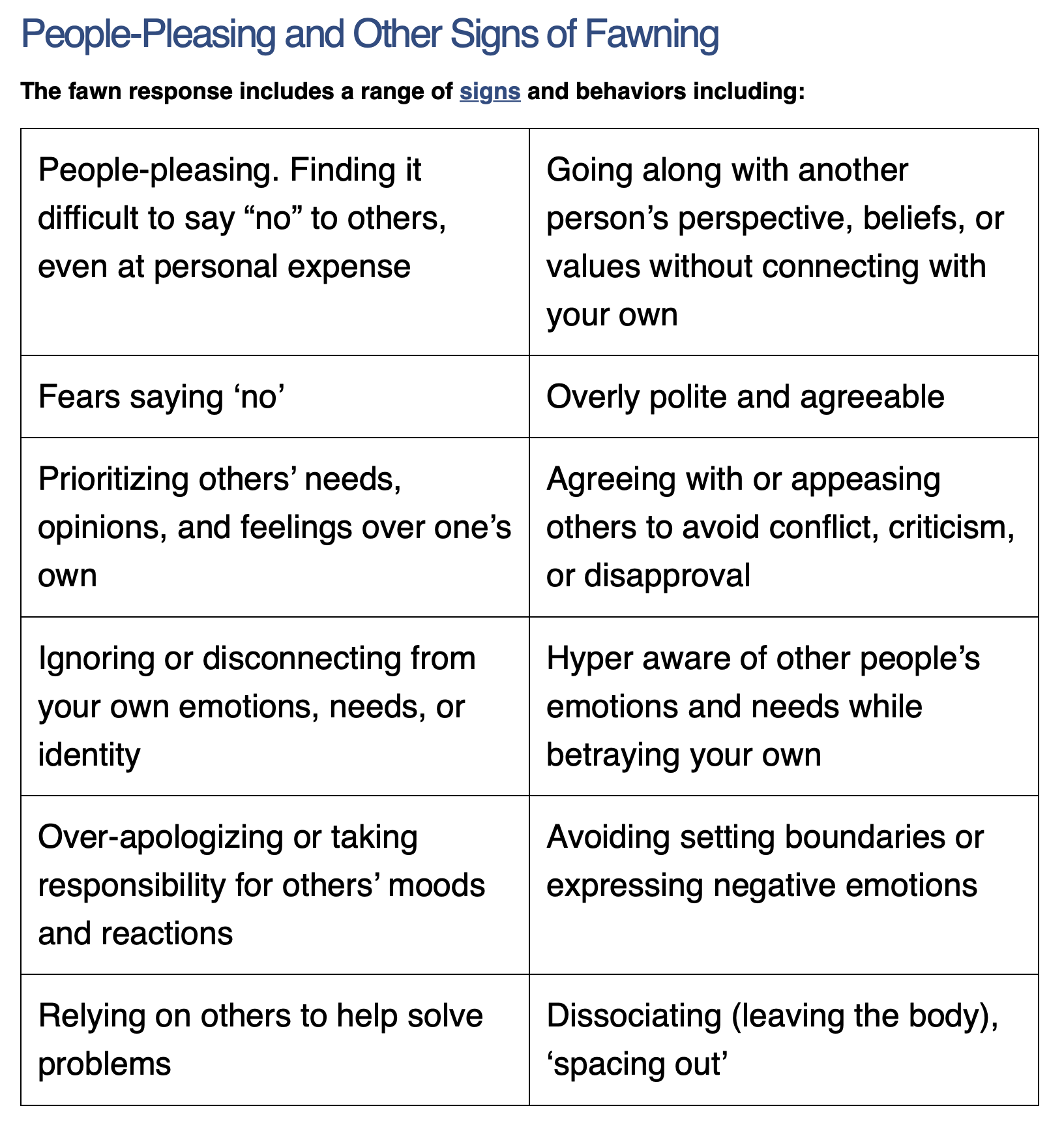Understanding Fawning
Photo: SPCA, Monterey County
By Sara Sorenson, LMHC, Clinic Director (Corner Canyon Health Centers)
While not well known, fawning is a trauma response characterized by excessive people-pleasing, appeasing, or submissive behavior. It is often a response to keep safe and avoid conflict or harm. Read on to learn more about this defense.
What Is Fawn Response in Trauma?
Most people have heard of the “fight” or “flight” responses to a threat, and possibly the “freeze” response. “Fawning”, however, is a lesser known defense, completing what are referred to as the “Four Fs” of trauma response. (A fifth, “flop” is also increasingly included).
The fawn response was first proposed by therapist Pete Walker, who described it as follows “Fawn types seek safety by merging with the wishes, needs, and demands of others. They act as if they unconsciously believe that the price of admission to any relationship is the forfeiture of all their needs, rights, preferences, and boundaries” [1].
When an individual tries to cope with danger by pleasing or appeasing a perceived threat, often at the cost of their own needs, boundaries, or emotions, it is referred to as fawning.
This is an instinctual response which typically develops as a survival mechanism in childhood or in prolonged situations of abuse, neglect, or conflict, such as with abusive caregivers, partners, or authority figures.
As a result, they turn their negative feelings toward themselves in the form of self-criticism, self-loathing, self-harming, or co-dependent behaviors. In adulthood, this may result in significant mental health issues involving co-dependency and physical ailments [2].
Why Does the Fawn Response Develop?
What gives rise to the fawn response? There are several key reasons [3][4]:
Adverse Childhood Events (ACEs): In the face of emotional, physical, or sexual abuse, the person tries to appease the abuser.
Caregivers who are emotionally immature, neglectful, or narcissistic
Intimate partner violence or toxic relationships that are ongoing
Living under chronic threat, bullying, or systemic/institutional abuse
The child (or adult) learns that compliance, helpfulness, and self-sacrifice can be effective to temporarily reduce threats, gain approval, or maintain emotional connection.
People-Pleasing and Other Signs of Fawning
The fawn response includes a range of signs and behaviors including:
People-pleasing. Finding it difficult to say “no” to others, even at personal expense
Going along with another person’s perspective, beliefs, or values without connecting with your own
Fears saying ‘no’
Overly polite and agreeable
Prioritizing others’ needs, opinions, and feelings over one’s own
Agreeing with or appeasing others to avoid conflict, criticism, or disapproval
Ignoring or disconnecting from your own emotions, needs, or identity
Hyper aware of other people’s emotions and needs while betraying your own
Over-apologizing or taking responsibility for others’ moods and reactions
Avoiding setting boundaries or expressing negative emotions
Relying on others to help solve problems
Dissociating (leaving the body), ‘spacing out’
While often such behaviors may be mistaken for genuine kindness or agreeableness, they’re often rooted in a deep-seated fear of rejection, punishment, or abandonment.
How the Fawning Response Affects Daily Life
There are many repercussions in daily life for those who fawn. They include [5][6]:
Difficulty Setting Boundaries
Fawning individuals struggle to say “no” or express their true feelings, fearing rejection or anger from others. For example, despite burnout, agreeing to extra work tasks, or staying in unhealthy relationships to avoid conflict.
Loss of Authenticity
People-pleasing may lead to denying your emotions, desires, and opinions.
Emotional Exhaustion
Energy may be drained from chronic self-neglect, leading to fatigue, anxiety, or depression.
Unhealthy Relationships
Engaging with manipulative or narcissistic partners or friends who exploit their subservience.
Physical Health Consequences
Migraines, digestive issues, or autoimmune disorders may result from the chronic stress of fawning.
Challenges in the Workplace
Burnout may result from overworking to gain approval, avoiding promotions (due to fear of competition), or being overlooked for lack of assertiveness.
Having Difficulty With Decisions
Being indecisive may result from dependency on others’ opinions to avoid making “wrong” choices.
Self-Blame and Shame
Anger and resentment at unmet needs may fuel resentment, often turned inward as shame.
Healing from Fawning: Tools and Therapy Approaches
Support groups for Complex Post-Traumatic Stress Disorder can be very helpful for those healing from the fawning response. Other forms of help include [6]:
Therapy: Trauma-informed approaches such as Internal Family Systems (IFS) or Eye Movement Desensitization and Reprocessing (EMDR) help reprocess trauma and address the fawning response.
Boundary-setting: Practice saying “no” in low-risk situations, such as declining a social invite, can help build self-esteem.
Journaling: Journaling can help to identify personal needs and then honor them.
Sources
[1] Walker, P. 2013. The 4Fs: A Trauma Typology in Complex PTSD. www.pete-walker.com
[2] Schwarz, A. The Fawn Response in Complex PTSD. www.drarielleschwarz.com
[3] Clayton, I. 2023. What Is the Fawning Trauma Response? Psychology Today.
[4] Elisabeth, J. 2022. Fawn: The Trauma Response That Is Easiest to Miss. Trauma Geek, Sept, 2022.
[5] Gaba, S. 2020. Understanding Fight, Flight, Freeze and the Fawn Response. Psychology Today.
[6] Mandeville, R. 2020. Recognizing the Complex Trauma-Based Fawn Response. Pacesconnection.com


